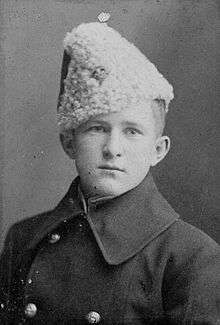Fur wedge cap
The Canadian military fur wedge cap, "envelope busby", or colloquially "The Astrakhan"[1][2] is a uniform hat worn by the Canadian military and RCMP. The outside of the cap is entirely covered in real (e.g. seal skin or Persian lamb) or synthetic fur and is shaped like a wedge. When not being worn the cap folds flat. The cap is about 8 inches (200 mm) high but is normally worn with the apex of the wedge shape depressed back into the interior of the cap to form a longitudinal trough at the crown, reducing the overall height. Often the cap is patterned such that the front of the crown will be slightly higher than the back. On one side of the military style fur wedge cap hangs a flat flap made of cloth or wool that extends from the crown to the bottom of the cap, known as the "bag". The colour of the "bag" was determined by the regimental colours (e.g. the RCMP bag was yellow). The bag is very similar to that worn with the busby. Because of the cap's passing resemblance to the hussar busby author and researcher James J. Boulton[3] dubbed it the envelope busby. Still, whatever influence the busby may have had on its design, the fur wedge cap pattern was "distinctly Canadian."[3]

The fur wedge cap was used by both the North-West Mounted Police (NWMP), later Royal Canadian Mounted Police (RCMP), with the first examples coming into service in 1876 until 1901 and then again from 1928 until 1935.[3] Today the RCMP wear the Yukon pattern of fur cap that is similar to the Russian ushanka style.[3][4] The other police unit that still regularly wears the fur wedge cap is the Toronto Police Mounted Unit as part of their full dress uniform. The Canadian military also wore the cap from about the end of the 19th century, and was formally adopted in the 1970s as the issued fur cap for all commands of the Canadian Forces during unification.[5] The bag was coloured rifle green. In Canadian Forces nomenclature it is known as Cap, Man's Winter, Fur, C.F. Exactly when the fur cap stopped being in general issue is unclear; however, it is still being worn today by the officer cadets of the Royal Military College of Canada.[1][6][2][7] As an example William Avery Bishop, Canadian flying ace, can be seen wearing the cap during his days in Royal Military College of Canada.
In popular culture
The fur wedge cap is prominently featured in the Cecil B. DeMille film North West Mounted Police (1940), with the mounted police characters all wearing the cap despite the fact that the movie is set in the summer time. (In real usage, the cap was not intended to be worn in summer.)
A civilian version of the cap without the bag was fashionable in Canada during the 1970s.
See also
- Karakul (hat)
- Wedge cap
References
- CBC Newsworld, Live coverage of the National Act of Remembrance, Ottawa, November 11, 2008: as reported by Maj. George Pearce Ret'd
- e-Veritas, July 24, 2016, Headdress of the Royal Military College of Canada: A brief history by 8057 Ross McKenzie, former Curator RMC Museum, http://everitas.rmcclub.ca/?p=154491 Archived 2016-08-13 at the Wayback Machine
- Boulton, James, J., Head-dress of the Canadian Mounted Police, 1873–2000, Calgary: Bunker to Bunker Pub., c2000., ISBN 1-894255-07-0, pages 89–96
- Ross, David, and Robin May, The Royal Canadian Mounted Police 1873–1987, London: Osprey, 1988., ISBN 0-85045-834-X
- Summers, Jack, L., Military uniforms in Canada, 1665–1970, Ottawa: National Museum of Man, National Museums of Canada, c1981., ISBN 0-660-10346-X
- Gregory, Michael, Compendium of Canadian Regiments: A Civilian's Perspective, Michaeljohn Gregory, ISBN 0-9688562-0-9 pages 59 to 60
- Canadian Forces, A-DH-265-000/AG-001 Canadian Forces Dress Instructions, Department of National Defence, pages 2-2-10 and 2-2-19, http://cs.uwindsor.ca/~fitzpatr/A-DH-265-000.pdf